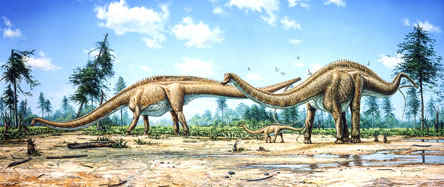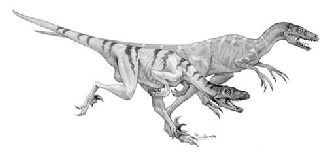
Diplodocus carnegii. Artwork © 1998 Michael Skrepnick
The Dinosauria
Dinosaurs, one of the most successful groups of animals (in terms of longevity) that have ever lived, evolved into many diverse sizes and shapes, with many equally diverse modes of living. The term "Dinosauria" was invented by Sir Richard Owen in 1842 to describe these "fearfully great reptiles," specifically Megalosaurus, Iguanodon, and Hylaeosaurus, the only three dinosaurs known at the time. The creatures that we normally think of as dinosaurs lived during the Mesozoic Era, from late in the Triassic period (about 225 million years ago) until the end of the Cretaceous (about 65 million years ago). But we now know that they actually live on today as the birds.
 Running Deinonychus. © 1995 B. Cunningham |
|
Some things to keep in mind about dinosaurs:
• Not everything big and dead is a dinosaur. All too often, books written (or movies made) for a popular audience include animals such as mammoths, mastodons, pterosaurs, plesiosaurs, ichthyosaurs, and the sail-backed Dimetrodon. Dinosaurs are a specific subgroup of the archosaurs, a group that also includes crocodiles, pterosaurs, and birds. although pterosaurs are close relations, they are not true dinosaurs. Even more distantly related to dinosaurs are the marine reptiles, which include the plesiosaurs and ichthyosaurs. Mammoths and mastodons are mammals and did not appear until many millions of years after the close of the Cretaceous period. Dimetrodon is neither a reptile nor a mammal, but a basal synapsid, i.e., an early relative of the ancestors of mammals.
• Not all dinosaurs lived at the same time. Different dinosaurs lived at different times. Despite the portrayals in movies like King Kong and Jurassic Park, no Stegosaurus ever saw a Tyrannosaurus, because Tyrannosaurus didn't appear on the scene until 80 or so million years following the extinction of stegosaurs. The same goes for Apatosaurus ("Brontosaurus") — it's bones were already well-fossilized by the time T. rex came along.
• Dinosaurs are not extinct. Technically. Based on features of the skeleton, most people studying dinosaurs consider birds to be dinosaurs. This shocking realization makes even the smallest hummingbird a legitimate dinosaur. So rather than refer to "dinosaurs" and birds as discrete, separate groups, it is best to refer to the traditional, extinct animals as "non-avian dinosaurs" and birds as, well, birds, or "avian dinosaurs." It is incorrect to say that dinosaurs are extinct, because they have left living descendants in the form of cockatoos, cassowaries, and their pals — just like modern vertebrates are still vertebrates even though their Cambrian ancestors are long extinct.
Find answers to some commonly asked questions about dinosaurs:
• Are birds really dinosaurs?
• What killed the dinosaurs?
• Were dinosaurs hot-blooded or cold-blooded?
• Can we infer the possible speeds of dinosaurs?
• Is what the movies tell us about dinosaurs true?
Visit these special exhibits on some popular dinosaurs:
• Learn about Tyrannosaurus rex, the most famous of all dinosaurs.
• Take an "audio tour" and hear about the discovery and reconstruction of Dilophosaurus from the discoverer himself, the late Sam Welles.
|
More about dinosaurs: 


 |
Sources and suggested further reading:
- Weishampel, D.B., P. Dodson, and H. Osmólska (eds.). 2004. The Dinosauria. 2nd edition. University of California Press, Berkeley. 833 pp. Simply put, the definitive text on dinosaurs. A bit technical for beginners, but exhaustive in detail; a "must have."
- Norell, M.A., E.S. Gaffney, and L. Dingus. 1995. Discovering Dinosaurs at the American Museum of Natural History. Nevraumont Publishing Company, Inc., New York. 204 pp. A current update of dominant thinking in dinosaur paleontology. Targeted for the layperson (with a good review of cladistics), but useful for all.
- Norman, D. 1985. The Illustrated Encyclopedia of Dinosaurs. Crescent Books, New York. 208 pp. Unfortunately out of press, still a great book on dinosaurs for all ages.
- Padian, K., and D. Chure (eds.). 1989. The Age of Dinosaurs: Short Courses in Paleontology Number 2. The Paleontological Society. 210 pp. For teachers, a book outlining how to run a course about dinosaurs.